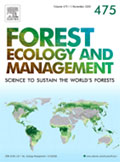In 2006, the Brazilian Forest Service (SFB) started an ambitious program to establish forest concessions so as to provide a legal framework for long-term sustainable timber production in Amazonian forests. Forest concessions in the Brazilian Amazon currently cover only 1.6 million ha (Mha) but we estimate the area of all potential concessions as 35 Mha.
This paper assessed the conditions under which the present and potential concession system can ensure an annual production of 11 Mm3. yr−1 to meet the estimated present timber demand. For this we used the volume dynamics with differential equations model (VDDE) calibrated for the Amazon Basin with a Bayesian framework with data from 3500 ha of forest plots monitored for as long as 30 years after selective logging.
 Predictions of commercial volume recovery rates vary with location. We tested 27 different scenarios by using combinations of initial proportion of commercial volume, logging intensity and cutting cycle length. These scenarios were then applied to the current area of concessions and to the area of all potential concessions (35 Mha). Under current logging regulations and the current concession area (mean logging intensity of 15–20 m3.ha−1, a harvest cycle of 35 years and an initial commercial timber volume proportion of 20%), timber production can be maintained only for a single cutting cycle (35 years). Only the scenario with a logging intensity of 10 m3ha−1 every 60 years with a 90% initial proportion of commercial timber species can be considered as sustainable. Under this scenario, the maximum annual production with the present concession areas is 159,000 m3 (157–159), or less than 2% of the present annual production of 11 Mm3. When considering all potential concession areas (35 Mha), under current rules, the total annual production is 10 Mm3yr−1 (2–17 Mm3yr−1, 95% credibility interval) but is not maintained after the first logging cycle.
Predictions of commercial volume recovery rates vary with location. We tested 27 different scenarios by using combinations of initial proportion of commercial volume, logging intensity and cutting cycle length. These scenarios were then applied to the current area of concessions and to the area of all potential concessions (35 Mha). Under current logging regulations and the current concession area (mean logging intensity of 15–20 m3.ha−1, a harvest cycle of 35 years and an initial commercial timber volume proportion of 20%), timber production can be maintained only for a single cutting cycle (35 years). Only the scenario with a logging intensity of 10 m3ha−1 every 60 years with a 90% initial proportion of commercial timber species can be considered as sustainable. Under this scenario, the maximum annual production with the present concession areas is 159,000 m3 (157–159), or less than 2% of the present annual production of 11 Mm3. When considering all potential concession areas (35 Mha), under current rules, the total annual production is 10 Mm3yr−1 (2–17 Mm3yr−1, 95% credibility interval) but is not maintained after the first logging cycle.
Under the most sustainable scenario (see above) and a concession area of 35 Mha, the long-term sustainable annual production of timber reaches only 3.4 Mm3yr−1. Based on these results we argue that the concession system will not be able to supply the timber demand without substantial reforms in natural forest management practices and in the wood industry sector. We argue that alternative sources of timber, including plantations linked with forest restoration initiatives, must be promoted.











